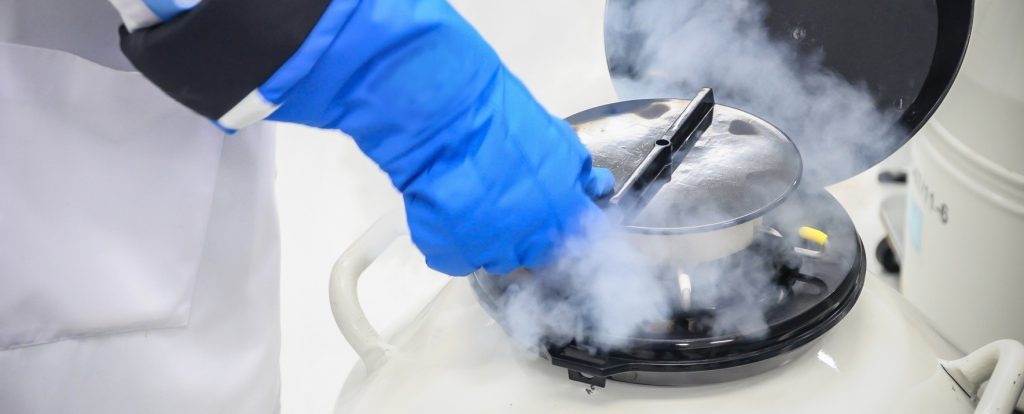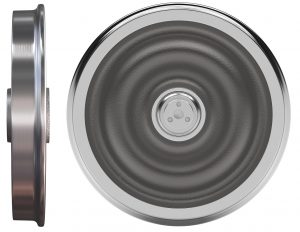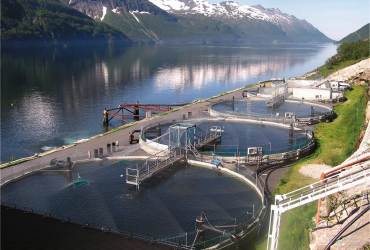
Mostly everything is nitrogen
We live in an atmosphere with lot of nitrogen – nevertheless, nitrogen is a relatively anonymous element. This is a bit of a shame as nitrogen has lots of good properties. Nitrogen is actually an essential element in many ways.
A small ampoule of sperm is lowered into a container of steel filled with liquid nitrogen. The container emits vapour and has the appearance of something out of a science fiction film, but it is just an example of applied biochemistry. The biochemist knows that the sperm can withstand its ice-cold meeting with the liquid nitrogen and that the sperm can survive in its frozen state for at least five years.
The fact that nitrogen is derived from air is hardly something the personnel at the sperm bank think about on a daily basis. For them, liquid nitrogen is simply an important co-formulant, just as it is for a number of other companies. Many of them take advantage of liquid nitrogen’s impressive ability to cool. Nitrogen reaches boiling point at minus 196 °C, which means that it goes from a liquid state to a gaseous state at this very low temperature. By comparison, water as we know, reaches boiling point at plus 100 °C – a difference of almost 300 °C therefore! Boiling nitrogen uses energy – lots of energy. It steals the energy from its surroundings, which in turn become cold. Extremely cold in fact. The technique is widely used to, e.g. freeze soil when major construction work is carried out underground. The frozen soil becomes rock hard, thus effectively preventing groundwater from seeping in. This method was used for, e.g. the construction of the Metro underground in Copenhagen.
Dislikes forming compounds
Most of the air that we breathe consists of nitrogen. Nitrogen is an element and approx. 78% of the atmosphere is made up of this element – the content was much higher than this at the beginning of time. In many ways, the existence of nitrogen is slightly anonymous. Nitrogen in the air is (fortunately!) invisible; it has no smell or taste and cannot burn. Its appearance is not particularly conspicuous, even when it cools down so much to become liquid. It simply turns into a colourless liquid.
If a human expression could be used for an element, nitrogen is also a little “shy” from a chemical point of view. The fact is that nitrogen does not like to form compounds with other substances. It actually is so reluctant that chemists almost regard it as an inert gas – an inert gas is a gas that is characterised by its stability and unwillingness to form chemical compounds.
 This is a property of nitrogen that is also utilised at an industrial level. When a food product label contains the words “Packaged in a protected atmosphere”, the principal element is often nitrogen. This is because when its own small atmosphere of pure nitrogen has surrounded the product, it is well protected against bacteria and other microorganisms, as they usually need oxygen to survive. Many areas of industry use gaseous nitrogen for the displacement of oxygen in the air. This is known as inerting. This also takes place in the petrochemical industry (oil/fuel), where the concentration of nitrogen eliminates fire and explosion hazards by displacing oxygen from tanks and pipes.
This is a property of nitrogen that is also utilised at an industrial level. When a food product label contains the words “Packaged in a protected atmosphere”, the principal element is often nitrogen. This is because when its own small atmosphere of pure nitrogen has surrounded the product, it is well protected against bacteria and other microorganisms, as they usually need oxygen to survive. Many areas of industry use gaseous nitrogen for the displacement of oxygen in the air. This is known as inerting. This also takes place in the petrochemical industry (oil/fuel), where the concentration of nitrogen eliminates fire and explosion hazards by displacing oxygen from tanks and pipes.
A terrestrial circuit
Despite its unwillingness, nitrogen does form compounds with certain other substances. And a good job too. This is because nitrogen is one of life’s building blocks and forms, among things, a very important component of proteins. But it has been difficult for nature to develop methods that are able to extricate nitrogen from the atmosphere – the Earth’s great warehouse for nitrogen. One of them – believe it or not – is a thunderstorm. A bolt of lightning warms the ambient air so much that the nitrogen, to coin a phrase, forgets its embarrassment and forms chemical compounds with the oxygen. This turns into nitrates and can be used by plants. Nitrogenous compounds are also sent out into the atmosphere when a volcano erupts.

But the available amount of nitrogen formed by lightning and volcanoes is limited. Therefore, a number of plants have taken action. They have developed the ability to extract nitrogen out of the air. Or rather: They have made themselves hosts for certain types of bacteria that are able to fixate nitrogen from the atmosphere. The bacteria typically reside in the plant’s tuber. There are approx. 190 kinds of plants that have mastered this magic trick – peas and beans are among the most familiar. Nitrogen has been provided with an efficient biological circuit thanks to these plants. Through the plants, the nitrogen is built into proteins eaten by animals – or us! So-called urea is secreted through urine and contains guess what? Correct: Nitrogen. But this is still chemically bound, and the nitrogen is only delivered back to the atmosphere with a letter of thanks after the urine is broken down. Excessive amounts of nitrogen can cause imbalance along the way, as nitrogen is an effective fertilizer, which can cause alga to flourish in lakes, fjords and the sea.
The air is a raw ingredient
In the world of industry, nitrogen is known as a gas. The name refers to the fact that the gas is among those that ordinary air is built up of, but it also implies that the gas can be produced with ordinary air as a raw ingredient. This takes place through a gradual compression and cooling of the air by a process known as the Hampson – Linde cycle. The method was independently patented by W. Hampson and C. von Linde in 1895. By the end of the process, the air is so cold that it turns into liquid – the nitrogen can then be separated from the other gases; oxygen and argon.
Previously, when it was technically impossible to produce nitrogen, “endogenous gas” was used: the air from a combustion of, e.g. town gas, where the oxygen content after combustion is very low and the endogenous gas is thus inactive. Large industries were in possession of endogenous gas generators at the factories, whereas nitrogen is now manufactured centrally and distributed to the various factories.

More and more use is being made of both gaseous and liquid nitrogen. Gaseous nitrogen is generally used in processes where the presence of oxygen results in unwanted chemical reactions. Liquid nitrogen is used for cooling and freezing, where its outstanding ability is used in connection with, e.g. the recycling of car tyres; The extreme cold makes the rubber brittle like glass, after which the tires are crushed into a granulate which is sorted into rubber, steel and textile.
Quick-freezing paint causes it to peel – liquid nitrogen is therefore also used to remove paint. Small residues of metal or rubber in casting moulds can be a major problem in the industry – but freezing the casting mould can often solve this. The small residues then fall off.
Increasing consumer demand for quality in the food industry also means that the use of liquid nitrogen is increasing, but one of the latest uses is for the power supply. The first superconducting power cable in the world was put into operation in 2001 in Amager, Denmark and is used in the ordinary power supply. At 30 meters, the cable is actually not that long, but it differs from other power cables on one essential point: It has a temperature of minus 190 °C and at that temperature there is no electrical resistance, which means that an incredible amount of energy is saved. There is no need to explain why the cable gets so cold – because once again, nitrogen is at work.
 Making the axle fits. An axle and a wheel must, by their very nature, fit well together. This is also something that is managed by nitrogen. An axle is cast so that it is slightly too big for the axle hole on the wheel. The axle is then cooled down sharply by liquid nitrogen. This causes the axle to shrink slightly – enough for it to be put in place on the bearing. This results in the axle being immovably fixed when the temperature rises again.
Making the axle fits. An axle and a wheel must, by their very nature, fit well together. This is also something that is managed by nitrogen. An axle is cast so that it is slightly too big for the axle hole on the wheel. The axle is then cooled down sharply by liquid nitrogen. This causes the axle to shrink slightly – enough for it to be put in place on the bearing. This results in the axle being immovably fixed when the temperature rises again.
 Discovery in 1770. Air was a scientific mystery for a long time. But in 1770, a medical student by the name of Daniel Rutherford discovered a way to trap some air by turning a jar in a water cask. After several tests, he found out that most of the air consisted of a substance that did not nourish fire. This was known as “burned air,” which meant air without oxygen. Nitrogen had been discovered.
Discovery in 1770. Air was a scientific mystery for a long time. But in 1770, a medical student by the name of Daniel Rutherford discovered a way to trap some air by turning a jar in a water cask. After several tests, he found out that most of the air consisted of a substance that did not nourish fire. This was known as “burned air,” which meant air without oxygen. Nitrogen had been discovered.
 Nitrogen in other languages. Chemists prefer the English name of nitrogen. In Danish it is called kvælstof (asphyxiating substance), which refers to the ability of the gas to “asphyxiate” a flame. The French call it azote, the Germans call it Stickstoff and the Swedish know it as kväve.
Nitrogen in other languages. Chemists prefer the English name of nitrogen. In Danish it is called kvælstof (asphyxiating substance), which refers to the ability of the gas to “asphyxiate” a flame. The French call it azote, the Germans call it Stickstoff and the Swedish know it as kväve.
Text: Ib Salomon
Photo: Shutterstock, Linde Brand Portal



